Fading Hope
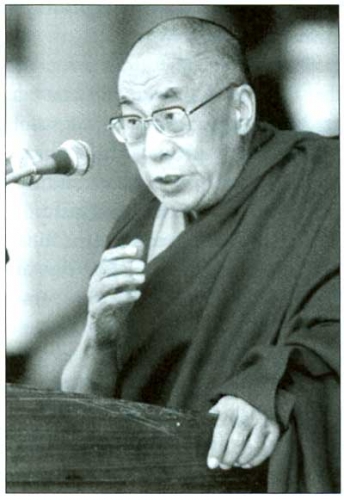
The Dalai Lama makes a much-anticipated return to the United Stares this May. During his monthlong stay he will visit the cities of Minneapolis, Portland, San Francisco, Los Angeles, San Jose, and Salt Lake City. Public events in the six cities have been sold out weeks in advance, with some organizers scrambling to add seats to venues booked at full capacity. In Utah, for example, an estimated 10,000 tickets were sold two months in advance of a May 12 teaching date, a response well above even the most optimistic expectations.
While the Dalai Lama’s popularity in the West has perhaps never been higher—his books now occupy a firmly established position on the best seller lists in the United States and Europe—his visit does come on the heels of several sobering developments for the Free Tibet movement.
The promise of renewed dialogue between Beijing and the Tibet government-in-exile has dissolved in recent months. Both sides exchanged guarded overtures for new discussions last December. but despite a secret visit to Beijing last July by the Dalai Lama’s brother, Gyalo Thondup, which brought hope of a shift in the hard-line position of Chinese leadership, subsequent requests for negotiations have been met with silence.
The Dalai Lama expressed his disappointment over the situation in a recent speech marking the occasion of the forty-second anniversary of the Tibetan uprising: “l sincerely hoped that this development would lead to an opening for a realistic approach to the Tibetan issue. I reasoned with the Chinese leadership that through face-to-face meetings we would succeed in clarifying misunderstanding and overcoming distrust . . . Yet, now they are stalling in accepting a Tibetan delegation. This is a clear indication of a hardening attitude of Beijing and a lack of political will to resolve the Tibetan problem.”
Although he expressed his firm belief that in the future there will be opportunity for open dialogue with China, the Dalai Lama’s decision to visit Taiwan in late March, over the adamant protests of the Chinese government, was sure to win him few supporters within its ranks.
In other recent Tibet-related news, Mary Robinson, the U.N. High Commissioner for Human Rights, unexpectedly announced in March that she will not seek a second term in the post. The often outspoken Robinson, who angered numerous governments—including China’s—by her criticism of their human rights records, was only the second person to serve in the post. In announcing her departure she described the resources available to her office as inadequate and cited the difficulties of working at the U.N. “I believe that I can, at this stage, achieve more outside of the constraints that a multilateral organization inevitably imposes.”
Vietnam
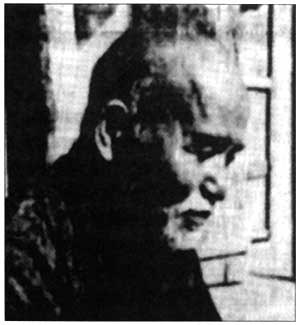
In Vietnam, authorities have once again detained the religious dissident and one-time Nobel Peace prize nominee Thich Quang Do, a senior figure in the banned Unified Buddhist Church of Vietnam (UBCV). According to reports, Quang Do was arrested in early February by security police in central Vietnam after visiting the church’s 82-year-old leader, Thich Huyen Quang, who has been under house arrest since 1981. This was the latest in a series of arrests—Quang Do has spent close to 20 years in prison since 1975. As reported in the Spring 2001 issue of Tricycle, he was last detained in October 2000 for distributing relief supplies to victims of the flooding in the Mekong delta. This most recent arrest came just a week before the U.S. Commission on International Religious Freedom was scheduled to hold hearings in Washington on violations of religious freedom and human rights in Vietnam and other nations. A UBCV exiled spokesperson was due to testify before the commission, fueling suspicion that Quang Do was arrested for attempting to gather information to present to the commission. Given the close scrutiny that government authorities havedirected toward Quang Do and other UBCV leaders in recent years, it is clear that Hanoi considers the church a political liability, one with the potential of disrupting the stability of the current regime. For his part, Quang Do continues to insist that he and the church have no political ambitions. In an interview conducted late last year by the Christian Science Monitor, Quang Do stated, “We are just for democracy, religious freedom, and human rights. As long as we have no freedom of expression and democracy, we cannot make . . . progress.”
On April 5, the U.S. Commission on International Religious Freedom recommended that action be taken against the Vietnamese government. In a letter to Secretary of State Colin Powell, the Commission argued that the United States should withhold its support for IMF and World Bank loans to the government of Vietnam until substantial improvements are made in the protection of religious freedom. “Despite the increase in religious practice among the Vietnamese people in the last ten years, the Vietnamese government suppresses organized religious activities forcefully and monitors and controls religious communities,” wrote Commission Chairman Elliott Abrams. “Individuals have been detained, fined, imprisoned, and kept under close surveillance by security forces for engaging in ‘illegal’ religious activities. ” For the full text of the Commission’s statement, visit USCIRF.
Digging For Dharma
Archaeologists in China have unearthed a miniature gold box that they believe contains the hair of the Buddha. According to a BBC report, the box, said to have been buried for over a thousand years, was unearthed during the excavation of the famous Leifeng Pagoda, built in 976 C.E. in the city of Hangzhou in eastern China. The Xinhua news agency reports that a group of archaeologists discovered a case in the collapsed cellar of the pagoda containing a tiny gold box. The box has not been opened, apparently for fear of damaging it. A similar relic, said to contain the first of two pieces of a single hair, was discovered in the north of China inthe 1970s.
In Burma, an English marine archaeologist has agreed to recover one of the country’s most sacred religious relics, the Dhammazedi Bell, from the depths of the lrrawaddy River, where it has lain for nearly 400 years. The bell, made of go1d, silver, and bronze and said to weigh 300 tons, once stood in the Shwedagon Pagoda, one of the country’s holiest shrines. In 1608, Portuguese raiders stole the bell from the temple and rolled it to the banks of the Irrawaddy, using elephants to load it onto a boat. The vessel sank in transit. Mike Hatcher, the archaeologist in charge of the restoration project, estimates that the operation will cost approximately $6 million, the funds to be provided privately. A crane similar to those used to raise oil platforms will be used to lift the bell, and a special railway line will be built from the river’s edge to the pagoda. The project has been stalled because of objections raised by pro-democracy activists, who are fearful that such an operation will be seen as an endorsement of the Burmese military regime.
Finally, in Phnom Penh, Cambodia, an international team of researchers has discovered over 100 headless Buddhist sculptures buried on the grounds of the Angkor Wat temple complex. According to lead archaeologist, Yoshiaki Ishizawa, the finding “proves that history saw a massive destruction of Buddhist sculptures…and that Buddhism came under attack all over Cambodia after the death of King Jayavarman VII in 1219.”
Building Buddhism
China has launched a major renovation of the world’s largest Buddha statue, the Leshan Buddha, in the southwestern province of Sichuan. At over 200 feet tall, the statue, a sitting Buddha carved into a river bluff, is 50 feet taller than the largest of the recently destroyed Buddhas of Bamiyan, Afghanistan. The statue, which dates back to the T’ang dynasty (618-907 C.E.), has been damaged in recent times by erosion and acid rain. The renovation project will cost approximately $30 million, with $2 million provided by World Bank loans. The Leshan Buddha was placed on the U.N. World Cultural Heritage list in 1996.
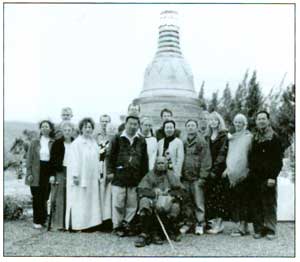
The first International Peace Pagoda to be built on the African continent became a reality recently after several years of planning. The pagoda was built under the supervision of Sayadaw U Thila Wunta, 90, the abbot of Dat Pon Zon Aung Min Gaung Monastery in Burma. He has built more than 500 peace pagodas in his native country and at least one on each continent, most recently in Africa. Funding for the construction came from benefactors in Canada and South Africa.
Yet another controversy surrounds a Buddhist temple in Canada. Great pine Forest Monastery, a Vietnamese Buddhist center in Harrington township outside of Montreal, has attracted the attention of local officials for its construction of eight large statues, or gayas, on the monastery’s property. The statues, some as tall as 25 feet, depict bodhisattvas and scenes from the life of the Buddha. Local authorities have claimed that the statues violate an agricultural zoning law. The monastery argues that it cannot afford the cost of moving them. The abbot of the community, Venerable Thich Thien Nghi, is in retreat, hoping to resolve the conflict through spiritual means.
Karmapa Update
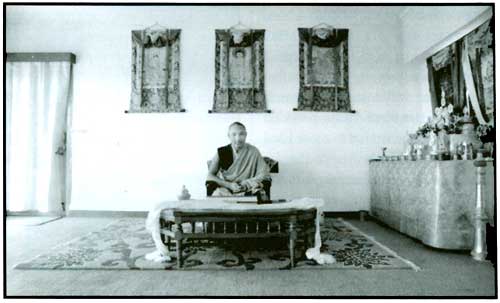
After more than a year-long wait, the 17th Karmapa, Ugyen Trinley Dorje, who escaped Chinese-controlled Tibet in January 2000, was finally granted refugee status by the Indian government in February. Soon thereafter, in March, the Karmapa, head of the Kagyu sect of Tibetan Buddhism, set outon a pilgrimage to the major Buddhist sites of India, busting Bodhgaya, Benares and Sarnath. Indian authorities continue to prevent him from traveling to Rumtek Monastery in Sikkim, the traditional seat of the Kagyu sect. Now and Indian state, Sikkim is also claimed by China. This photograph was taken by Sandra Lee at Gyuto Monastery un Dharamsala, October, 2000.
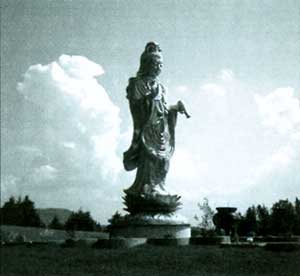
Milarepa’s Mountain
“Mt. Kailash is the axis mundi, the cosmic pillar that upholds the vault of heaven.” So begins Robert Thurman and Tad Wise’s Circling the Sacred Mountain, a book chronicling the author’s journey to Mt. Kailash and their traverse around it’s base at 18,600 feet above sea level. Many pilgrims have undertaken this circumambulation of one of Tibetan Buddhism’s grandest sacred sites; one trip around the mountain is said to cleanse the sins of a lifetime.
Since Tibet’s great saint Milarepa ascended the mountain in the eleventh century (as legend has it, he rode to the summit on the rays of the morning sun), no one has scaled the holy peak. Chinese authorities in Tibet, in an affront to Tibetan religion, have asked a Spanish expedition, led by climber Jesus Martinez Novas, to climb to the summit of Mt. Kailash.
London’s Observer quotes the Free Tibet Campaign: “If the Chinese authorities were to allow this climb, it would be symbolic of their attempts to crush Tibetan culture and religion, which they see as obstacles to economic progress and political control.” And representatives of H.H. the Dalai Lama have said, “Mt. Kailash should not be made a sporting arena. It won’t just offend Buddhists, it will offend Hindus as well.”
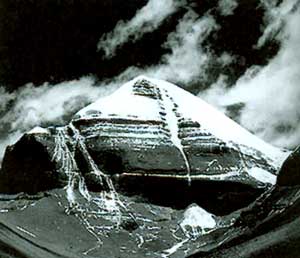
In fact, Hindus of varying traditions hold Kailash to be of enormous importance. It is the home of Siva, according to his followers, while followers of Vishnu see Kailash as the earthly manifestation of the cosmic mountain Sumeru, which sits at the center of the universe.
The Chinese government has apparently been encouraging European climbers to tackle the mountain since the mid-eighties, but no one has accepted the offer. Climber Reinhold Messner, who was invited to scale Kailash and refused, has said, “If we conquer this mountain, the we conquer something in other people’s souls.”
According to the Observer, Chinese authorities in Lhasa have praised the contribution of mountaineers in Tibet as a “triumphant song of patriotism, collectivism, internationalism and revolutionary heroism,” insisting that foreign climbing expeditions are helpful to Tibet’s economic development.

A Note From Dharamsala
On March 15, 2001, Tricycle‘s Christine Dzialo met with Jetsun Pema, sister of His Holiness the Dalai Lama and President of Tibetan Children’s Villages (TCV), to talk about the 40th anniversary of the organization and its continuing mission.
“The TCV was started in 1960 when Mrs. Tsering Doma Takla, my sister, volunteered to look after fifty-one ill children arriving from road construction camps. TCV now has in its care 14,000 students in over twenty schools in India.
“In order for the Tibetan culture to survive in exile, generations to come must be fluent in all areas of Tibetan language. Reading and chanting Buddhist prayers is a part of the day, and a lama teaches classes that are optional.
“But it is in thecompassionate behavior of the children where we can see Buddhist philosophy revealed in the most simple of manners. Just look outside my window and we can see the small ones removing inchworms from the walkway to save them from being crushed.” —Jetsun Pema
The Wheel

Flower Power Tiny white flowers are blooming on the gilded brow of a statue of Kuan Yin in Seoul. South Korea,and the apparition is drawing tens of thousands of pilgrims. The flowers have never blossomed in the thousand-year history of the monastery, and their appearance is believed to herald a momentous event.
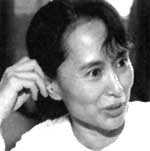 Rock for Freedom This winter, Burmese Pro-democracy leader Aung San Suu Kyi was awarded the Presidential Medal of freedom, America’s highest civilian honor. At the same time, Burmese authorities have banned the latest CD by the popular rock group U2; one of the songs on the album, “Walk On,” honors Suu Kyi. Anyone in Burma found in possession of the CD is subject to twenty years’ imprisonment.
Rock for Freedom This winter, Burmese Pro-democracy leader Aung San Suu Kyi was awarded the Presidential Medal of freedom, America’s highest civilian honor. At the same time, Burmese authorities have banned the latest CD by the popular rock group U2; one of the songs on the album, “Walk On,” honors Suu Kyi. Anyone in Burma found in possession of the CD is subject to twenty years’ imprisonment.
 Top Elephant Sri Lanka’s holiest Buddhist shrine, the Temple of the Tooth, is still looking for a replacement for the nationally beloved Raja, an elephant who died 12 Years ago. Since the sacred elephant—leader of a yearly procession bearing the 34 relics of the Buddha—must remain celibate, the rare physical attributes necessary for this prestigious job are not passed to an heir.
Top Elephant Sri Lanka’s holiest Buddhist shrine, the Temple of the Tooth, is still looking for a replacement for the nationally beloved Raja, an elephant who died 12 Years ago. Since the sacred elephant—leader of a yearly procession bearing the 34 relics of the Buddha—must remain celibate, the rare physical attributes necessary for this prestigious job are not passed to an heir.
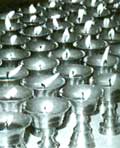 Virtual Light Now you can offer a prayer—complete with flickering butter-lamp—via email thanks to the website of Hollywood’s Kagyu Shedrup Chollng Tlbeun Dharma Center. Prayers emailed to the website are read to the congregation at the center before the lighting of 108 real butter-lamps every Sunday morning.
Virtual Light Now you can offer a prayer—complete with flickering butter-lamp—via email thanks to the website of Hollywood’s Kagyu Shedrup Chollng Tlbeun Dharma Center. Prayers emailed to the website are read to the congregation at the center before the lighting of 108 real butter-lamps every Sunday morning.
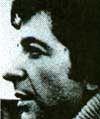 Silent No More Leonard Cohen, known for the last five Years as Jikan, “the silent one,” is leaving his Mt. Baldy retreat after years of intensive Rinzai Zen practice. The brooding poet-singer-songwriter is working on his first studio album in nearly ten years. He says: “Religion is my favorite hobby… nothing is comparable to the delight you get from this activity.”
Silent No More Leonard Cohen, known for the last five Years as Jikan, “the silent one,” is leaving his Mt. Baldy retreat after years of intensive Rinzai Zen practice. The brooding poet-singer-songwriter is working on his first studio album in nearly ten years. He says: “Religion is my favorite hobby… nothing is comparable to the delight you get from this activity.”
 Bookmark This Ever yearn to watch a dharma discourse in streaming video? Patna, India’s Buddhist Heritage Project has announced the launch of its new websitewww.bodhitreenews.com on May 7. Along with Internet videos of eminent teachers, the site will offer sangha news, free email, pilgrimage information, and dharma e-greetings.
Bookmark This Ever yearn to watch a dharma discourse in streaming video? Patna, India’s Buddhist Heritage Project has announced the launch of its new websitewww.bodhitreenews.com on May 7. Along with Internet videos of eminent teachers, the site will offer sangha news, free email, pilgrimage information, and dharma e-greetings.
 Ciao Buddha Until this year the only religions officially recognized in Italy were Christianity and Judaism. This fall, though, Buddhism became an Italian state religion and its Buddhist monks and nuns now have the same rights as the Catholic and Jewish counterparts. If you’ve always fancied a zen wedding in Venice, your time has come.
Ciao Buddha Until this year the only religions officially recognized in Italy were Christianity and Judaism. This fall, though, Buddhism became an Italian state religion and its Buddhist monks and nuns now have the same rights as the Catholic and Jewish counterparts. If you’ve always fancied a zen wedding in Venice, your time has come.
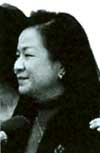 Temple Trauma Maria Hsia, the 50-year old ex-Democratic Fund-raiser implicated in the Jsi Lai Temple debacle, will not go to prison. Instead, the woman responsible for linking the phrase “Buddhist temple” with “scandal” will be confined to her home for three months, serve three years of probation, and pay a $5,000 fine. She is also prohibited from doing any political fund-raising for three years.
Temple Trauma Maria Hsia, the 50-year old ex-Democratic Fund-raiser implicated in the Jsi Lai Temple debacle, will not go to prison. Instead, the woman responsible for linking the phrase “Buddhist temple” with “scandal” will be confined to her home for three months, serve three years of probation, and pay a $5,000 fine. She is also prohibited from doing any political fund-raising for three years.
 School Days This August 17, Soka Gakkai International, (a lay Buddhist organization with eight million followers) will open the doors of Soka University of America to 120 freshmen. The four-year undergraduate university—perched on a 103-acre hilltop site in Aliso Viejo, California—is open to students of all beliefs and nationalities.
School Days This August 17, Soka Gakkai International, (a lay Buddhist organization with eight million followers) will open the doors of Soka University of America to 120 freshmen. The four-year undergraduate university—perched on a 103-acre hilltop site in Aliso Viejo, California—is open to students of all beliefs and nationalities.
Thank you for subscribing to Tricycle! As a nonprofit, we depend on readers like you to keep Buddhist teachings and practices widely available.